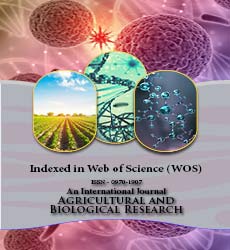Agricultural and Biological Research
RNI # 24/103/2012-R1
Tilaye Aregu Haile, Ali Seid Mohammed and Amare Bitew Mekonnen*
This study was conducted to evaluate the woody plant diversity, structure, and regeneration status of Nacho restoration forest. Thirty plots of 20 m × 20 m were laid at about 100 m intervals along the transect lines for vegetation data collection. The number of sampled quadrats was determined based on the principle of species-area curve. In addition, 5 subplots (5 m × 5 m) were laid within each main plot to collect seedling and sapling data of woody species. Diversity was determined using Shannon Wiener index (H') and communities were classified with SPSS-20. A total of 64 woody species belonging to 51 genera and 31 families were in the forest. The overall H' and evenness values were 3.6 and 0.9, respectively. The analysis of the Diameter at Breast Height (DBH) distribution shows an inverted J-shaped pattern indicating the healthiness of the forest. The total basal area of the forest was 226.6 m2ha-1. Stems ha-1 densities were 514.2 for mature, 538.1 for saplings, and 937.5 for seedlings. These structural data revealed that the forest is in the secondary stage of development and some species require urgent conservation. Based on the results of this study appropriate restoration is recommended to develop woody plant composition, diversity, and conservation in degraded mountain forests even in towns.
